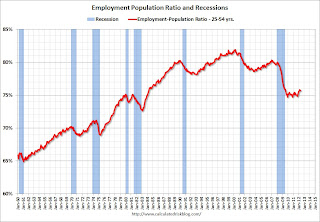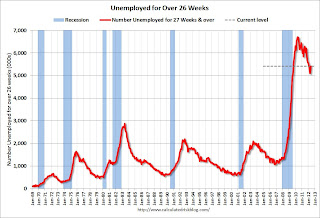by Calculated Risk on 6/01/2012 11:50:00 AM
Friday, June 01, 2012
May Employment Summary and Discussion
Another month, another disappointing employment report.
There appeared to be some additional weather related "payback" in May offsetting the relatively solid job growth during the winter months. As an example, construction employment was down 28,000 (seasonally adjusted), and "leisure and hospitality" declined by 9,000 jobs. Both were up solidly Not Seasonally Adjusted (NSA) in May. Construction was up 169,000 jobs, and leisure and leisure and hospitality increased 312,000 jobs NSA, but this is less than usual in May - probably because of the hiring during the winter - and the seasonally adjusted numbers were down. This weather "payback" is probably over now.
If we average over the first five months of the year, the economy has added 164,600 jobs per month (169,400 private sector per month). At this pace, the economy would add around 2 million private sector jobs in 2012; about the same as in 2011.
However weather payback probably only accounts for some of the recent slowdown in hiring.
Some numbers: There were 69,000 payroll jobs added in May, with 82,000 private sector jobs added, and 13,000 government jobs lost. The unemployment rate increased to 8.2%. The household survey showed a strong increase in employment (422,000 jobs added), but the participation rate increased too (from 63.6% to 63.8%) so that pushed up the unemployment rate. The household survey job gains - and increase in the participation rate - are small positives.
U-6, an alternate measure of labor underutilization that includes part time workers and marginally attached workers, increased so 14.8%.
The change in March payroll employment was revised down from +154,000 to +143,000, and April was revised down from +115,000 to +77,000.
The average workweek declined to 34.4 hours, and average hourly earnings increased slightly. "The average workweek for all employees on private nonfarm payrolls edged down by 0.1 hour to 34.4 hours in May. ... In May, average hourly earnings for all employees on private nonfarm payrolls edged up by 2 cents to $23.41. Over the past 12 months, average hourly earnings have increased by 1.7 percent.
There are a total of 12.7 million Americans unemployed and 5.4 million have been unemployed for more than 6 months.
The bottom line is this was another disappointing employment report.
Employment-Population Ratio, 25 to 54 years old
 Click on graph for larger image.
Click on graph for larger image.
Since the participation rate has declined recently due to cyclical (recession) and demographic (aging population) reasons, an important graph is the employment-population ratio for the key working age group: 25 to 54 years old.
In the earlier period the employment-population ratio for this group was trending up as women joined the labor force. The ratio has been mostly moving sideways since the early '90s, with ups and downs related to the business cycle.
This ratio should probably move back to or above 80% as the economy recovers. So far the ratio has only increased slightly from a low of 74.7% to 75.7% in May (this was unchanged in May from April.)
Percent Job Losses During Recessions

This graph shows the job losses from the start of the employment recession, in percentage terms - this time aligned at maximum job losses.
In the earlier post, the graph showed the job losses aligned at the start of the employment recession.
Part Time for Economic Reasons
 From the BLS report:
From the BLS report:
The number of persons employed part time for economic reasons (sometimes referred to as involuntary part-time workers) edged up to 8.1 million over the month. These individuals were working part time because their hours had been cut back or because they were unable to find a full-time job.The number of part time workers increased in May to 8.1 millon.
These workers are included in the alternate measure of labor underutilization (U-6) that increased in May to 14.8%, up from 14.5% in April.
Unemployed over 26 Weeks
 This graph shows the number of workers unemployed for 27 weeks or more.
This graph shows the number of workers unemployed for 27 weeks or more. According to the BLS, there are 5.4 million workers who have been unemployed for more than 26 weeks and still want a job. This was up from 5.1 million in April. This reversed the decline over the previous two months, although the number is still down since the beginning of the year. Long term unemployment remains one of the key labor problems in the US.


